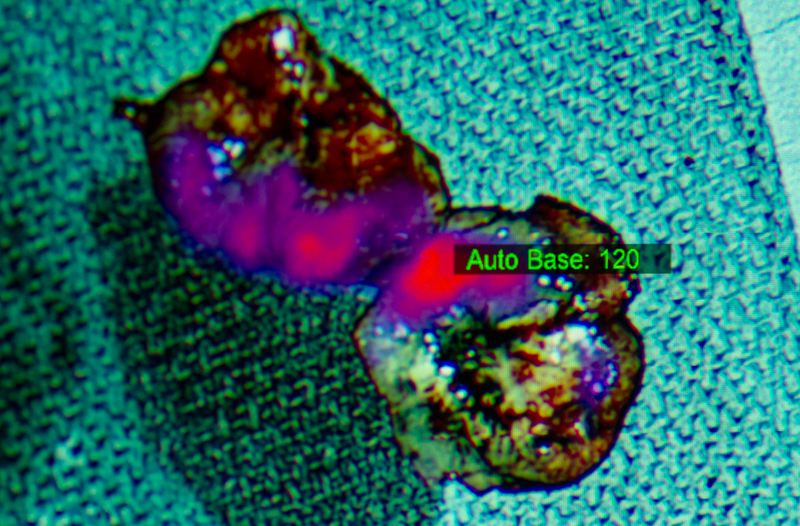‘Glowing Tumor’ imaging drug will revolutionize lung cancer surgery
The U.S. Food and Drug Administration (FDA) has approved the targeted imaging agent Cytalux (pafolacianine) for use in lung cancer surgery.

[Dec. 18, 2022: Hannah Messinger, UPenn]
This injectable diagnostic binds to cancerous tissue and glows when stimulated by near-infrared light. (CREDIT: UPenn Medicine)
The U.S. Food and Drug Administration (FDA) has approved the targeted imaging agent Cytalux (pafolacianine) for use in lung cancer surgery. This injectable diagnostic binds to cancerous tissue and glows when stimulated by near-infrared light, making it easier for surgeons to remove tumors completely while sparing healthy tissue.
Thoracic surgeons at the Center for Precision Surgery in the Abramson Cancer Center at the University of Pennsylvania led the clinical trials evaluating the imaging agent in lung cancer, in a partnership with the Indiana-based manufacturer, On Target Laboratories. This is the second approval for Cytalux, following an approval last year for ovarian cancer surgery, also based on clinical studies in which Penn Medicine led one of the largest sites in country.
“The availability of this imaging agent has major implications for thoracic surgery and lung cancer patients, who make up the vast majority of thoracic surgery cases,” said Sunil Singhal, MD, the William Maul Measey Professor in Surgical Research and director of the Center for Precision Surgery at Penn Medicine.
“It will allow us to do less invasive operations, find additional cancer, and more accurately detect any remaining cancer, potentially saving patients from reoperation or additional therapy.”
Related Stories:
More than 130,000 Americans die of lung cancer each year, making lung cancer the leading cause of cancer mortality in the country. Lung cancer mortality is high largely because it tends to be diagnosed at later stages when the tumor has begun to spread.
About 20 percent of cases, or roughly 50,000 per year, are localized enough to be treated surgically, in the hope of a cure. But even with surgery there is a high chance of recurrence, which implies that standard visual and tactile inspection often fails to detect all cancerous tissue.
Cytalux was designed to enhance this detection rate in surgeries where the tumor is removed. The imaging drug is infused into the patient pre-operatively, and binds to a surface protein called the folate receptor alpha (FRα), which is expressed at abnormally high levels in lung tumors and several other types of tumor.
The imaging agent is designed so that, under illumination with infrared light, it will produce a glowing emission that can be detected by a special infrared camera. The camera outputs to a real-time display, enhancing the surgeon’s ability to see probable cancerous tissue. This type of technology is known as intraoperative molecular imaging.
The randomized Phase III ELUCIDATE trial (NCT04241315), completed last year, showed that the imaging agent helped detect cancer that would have been missed by conventional techniques in more than 50 percent of patients with confirmed or suspected lung cancer. Singhal was the principal investigator of the multi-site study.
Penn Medicine has led the field of intraoperative imaging, driving advancements to bring this imaging agent to patients.
As a pioneer in the field of tumor imaging, Singhal has been working with Cytalux for nearly a decade, spearheading efforts to study it in hundreds of surgeries, in both clinical trials and exploratory studies, for ovarian and lung cancer.
Thoracic surgeons at the Center for Precision Surgery in the Abramson Cancer Center at the University of Pennsylvania. (CREDIT: UPenn)
The Center for Precision Surgery and its affiliated Penn Medicine researchers have also developed several other innovative technologies for imaging brain, breast, head and neck, and urinary tract cancers.
“Today’s approval gives thoracic surgeons a new tool to accurately detect and remove cancer tissue, while sparing healthy lung tissue,” Singhal said. “With intraoperative molecular imaging, our ultimate goal is to improve patient care through more precise surgery.”
What are the symptoms of lung cancer?
According to the CDC, different people have different symptoms for lung cancer. Some people have symptoms related to the lungs. Some people whose lung cancer has spread to other parts of the body (metastasized) have symptoms specific to that part of the body.
Some people just have general symptoms of not feeling well. Most people with lung cancer don’t have symptoms until the cancer is advanced. Lung cancer symptoms may include:
Coughing that gets worse or doesn’t go away.
Chest pain.
Shortness of breath.
Wheezing.
Coughing up blood.
Feeling very tired all the time.
Weight loss with no known cause.
Other changes that can sometimes occur with lung cancer may include repeated bouts of pneumonia and swollen or enlarged lymph nodes (glands) inside the chest in the area between the lungs.
These symptoms can happen with other illnesses, too. If you have some of these symptoms, talk to your doctor, who can help find the cause.
Note: Materials provided above by UPenn. Content may be edited for style and length.
Like these kind of feel good stories? Get the Brighter Side of News' newsletter.



